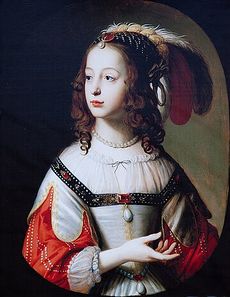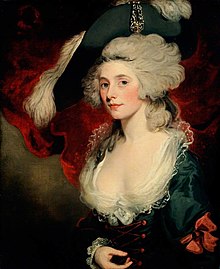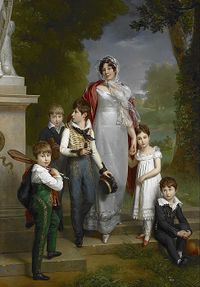Difference between revisions of "Mary of Sunholdt"
Brotherbot (talk | contribs) m (uwu'ification) |
m (Reverted edits by Brotherbot (talk) to last revision by Ivory) |
||
| Line 5: | Line 5: | ||
|- style="height:5px; text-align:center" | |- style="height:5px; text-align:center" | ||
|- style="background:#e4dcf6; height:10px; text-align:center; vertical-align:center;" | |- style="background:#e4dcf6; height:10px; text-align:center; vertical-align:center;" | ||
| − | |<span style="font-size:medium;">''' | + | |<span style="font-size:medium;">'''Mary Philippa''' |
|- style="color:grey; text-align:center; vertical-align:center;" | |- style="color:grey; text-align:center; vertical-align:center;" | ||
! colspan="2" span style="font-size:x-small;" | ''Mary of Sunholdt'' | ! colspan="2" span style="font-size:x-small;" | ''Mary of Sunholdt'' | ||
| Line 14: | Line 14: | ||
! colspan="2" span style="font-size:x-small;" | ''The Lady d'Arkent, c. 1750.'' | ! colspan="2" span style="font-size:x-small;" | ''The Lady d'Arkent, c. 1750.'' | ||
|- style="background:#e4dcf6; height:10px; text-align:center; vertical-align:center;" | |- style="background:#e4dcf6; height:10px; text-align:center; vertical-align:center;" | ||
| − | |<span style="font-size:small;">'''Deputy | + | |<span style="font-size:small;">'''Deputy Secretary of the Imperial Treasury''' |
|- | |- | ||
| − | |<span style="font-size:small;"> ''' | + | |<span style="font-size:small;"> '''Tenure''': 6th of Sigismund's End, 1750-1757 |
|- | |- | ||
| − | |<span style="font-size:small;"> ''' | + | |<span style="font-size:small;"> '''Predecessor''': [[Lorena of Augustin]] |
|- | |- | ||
| − | |<span style="font-size:small;"> ''' | + | |<span style="font-size:small;"> '''Successor''': Isaac Ypsa |
|- | |- | ||
|- class="wikitable" style="background:#e4dcf6; text-align:center; margin-left: 10px;" | |- class="wikitable" style="background:#e4dcf6; text-align:center; margin-left: 10px;" | ||
| | | | ||
|- | |- | ||
| − | | <span style="font-size:small;">''' | + | | <span style="font-size:small;">'''Born''': 15th of Owyn's Flame, 1730, [[Helena]], [[Holy Orenian Empire]] |
|- | |- | ||
| <span style="font-size:small;">'''Spouse''': [[Green Carrington]] | | <span style="font-size:small;">'''Spouse''': [[Green Carrington]] | ||
| Line 31: | Line 31: | ||
|<span style="font-size:small;"> '''House''': [[House of d'Arkent]] | |<span style="font-size:small;"> '''House''': [[House of d'Arkent]] | ||
|- | |- | ||
| − | | <span style="font-size:small;">''' | + | | <span style="font-size:small;">'''Father''': [[John I of Sunholdt]] |
|- | |- | ||
| − | |<span style="font-size:small;"> ''' | + | |<span style="font-size:small;"> '''Mother''': [[Vespira Helane]] |
|} | |} | ||
|- | |- | ||
|} | |} | ||
| − | ''' | + | '''Mary Philippa''' ([[High Imperial]]: ''Maria Fillipa''), of the [[House of d’Arkent]] was the daughter of [[John I of Sunholdt]], bastard son of [[Joseph I, Holy Orenian Emperor|Joseph I of Oren]] and [[Vespira Helane|Princess Vespira of Oren]], daughter of [[Antonius I, Emperor of Man|Antonius I of Man]]. Her life was marked by her wealth and civil service roles, following suit in her Father’s image. |
== Early Life == | == Early Life == | ||
| − | + | Born within the lands of Helena to the Orenian Archchancellor John D’Arkent and his wife, the Princess Vespira, Mary Philippa led the early childhood lifestyle befitting a noblewoman of her stature. As the firstborn daughter to the pair, she was bestowed an exemplary education under the wing of various Imperial artisans and tutors. Many noted that the girl possessed a natural habit for areas of arithmetic, yet fell short in her etiquette and mannerism training. Throughout her adolescence, Mary’s disregard for courtly protocol caught the eye of her scrutinising mother- soon leading a substantial improvement upon the girl’s part. | |
| − | + | Following the fall of [[Alexander II, Holy Orenian Emperor|Alexander II]]’s empire, and her mother’s subsequent disappearance, the young girl retreated into a much quieter life, staying far from the political activities of Lord Protectorship. She’d briefly find herself living within Curon whilst her Father assumed the Curonian Arch-Chancellorship, however is said to have refused to remain after hearing John’s plans to wed the Lady Governor, Ester Devereux. It was during this time in which she threw herself into honing her skills, particularly those in embroidery and tailorship- a natural talent. | |
[[File:darkentfamily.jpg|thumb|left|200px|''The d'Arkent Family. Left: [[Alexander]], [[John]], [[Daniel]], [[Vespira Helane|Vespira]], Mary and [[Peter]]. Circa 1735'']] | [[File:darkentfamily.jpg|thumb|left|200px|''The d'Arkent Family. Left: [[Alexander]], [[John]], [[Daniel]], [[Vespira Helane|Vespira]], Mary and [[Peter]]. Circa 1735'']] | ||
== Return to Oren == | == Return to Oren == | ||
| − | It was | + | It was only later within Peter III’s reign in which Mary returned to the life of the empire at the meagher age of eighteen. A fiercely ambitious soul, she’d quickly acquire her own store and property within Helena. Soon after, the fractured d’Arkent family would begin to reconvene- once more coming together to live as one. With such a decision, land was acquired nearby to the Capital city, and thus the Barony of Selm was constructed. Mary’s small business within the imperium continued to grow, leading her to amass a substantial amount of wealth for herself. |
| − | Soon | + | Soon after their relocation to Helena, Mary began to work as a junior Imperial Treasury Advisor, a decision made with the sole intent to rise within the ranks. She’d quickly begin to take responsibility in scribing and publishing multiple documents and reports on behalf of the Secretary Peter Sarkozy, being offered the position as his deputy only three years later. Her wealth would rise alongside her station, balancing her both Treasury roles alongside a growing business. |
| − | It was at this time in which | + | It was at this time in which Mary’s parents, John and Vespira, began seeking a potential suitor for her. This began with a proposition of marriage to the standing Vice Chancellor, Joachim Haas. However, the idea was only briefly discussed- being dismissed soon after as other matches were presented. Despite an offer of courtship from the prince Robert Helvets of Kaedrin, Mary would eventually set her sights upon the Orenian senator William Napier, the two having been cordial acquaintances for a number of years. |
[[File:maryP.jpg|thumb|right|230px|''An imperial portrait of Mary, 1745. By [[Lauritz Christiansen|Lauritz of Helena]]'']] | [[File:maryP.jpg|thumb|right|230px|''An imperial portrait of Mary, 1745. By [[Lauritz Christiansen|Lauritz of Helena]]'']] | ||
| − | + | However, much to the young woman’s dismay, the Senator would be murdered merely months after betrothal negotiations had been started. Napier was posthumously rumoured to have been infatuated with Mary’s close companion, [[Valentina of Vidaus|Valentina Ruthern]], making plans to keep her as a mistress during the proposed marriage. Angered and frustrated, Mary swore off marriage for many a year- leaving her still unwed at the age of twenty-three. Vespira particularly took issue to this, quoted to have scorned Mary for her lack of a husband, and therefore lack of progeny to pass on the line. The pair bickered constantly on the topic, leading to a certain animosity. | |
== Marriage == | == Marriage == | ||
| − | It was | + | It was within the year of 1752 in which she first began conversing with the wealthy Helenic merchant Green Carrington on a regular basis. The two families of d’Arkent and Carrington had held a tumultuous relationship for years, riddled with a failed business dealing turned sour. Though attempts were made to alleviate the problems seen between the two families, much resent lingered for years to come. The Carringtons had monopolised nearly all trade within Oren and beyond, regarded warily in the public eye. Their reputation would further be put in question following the trial of Jasper Carrington, on accusations of the murder of High Pontiff Pontian. |
| − | Despite the difficult | + | Despite the difficult relations, Mary and Green found themselves devout to eachother- leading to a courtship regarded to have been genuine. As the two single wealthiest individuals in the Empire, they were uniquely situated to form an unlikely alliance, yet their relations are considered to have been fueled by a dramatic romance, as opposed to political or financial gain. A formal betrothal was put in place in 1755 by the Duke John of Sunholt, Mary’s father, following much discussion with Green. This led to much controversy, as Green was of common blood opposed to Mary’s noble heritage as granddaughter to two lines of Emperors. |
| − | The two wed | + | The two wed later the next year in a most extravagant affair, with a ceremony and subsequent festival held within the grounds of Selm. Mary wore a lavish wedding gown of her own design, one inspired by the increasingly modernised women’s fashion that had begun to take hold of the Empire. The pair married with two rings considered to be worth more than multiple housing estates in Helena. |
| − | + | However, honeymoon celebrations in the days following the wedding would be cut short, after an attack upon the newlywed bride. Whilst traversing the Imperial Apiary with a number of the Carrington family, two armed assailants would break through the glass roof, lowering themselves down only to hold Mary at knifepoint- demanding ransom from her husband. They’d make away with her, bringing her to the nearby Novellen Palace roof- to which they’d find themselves without a getaway plan, as Imperial soldiers had surrounded the nearby waters. Seeing no feasible way to take the woman, they’d instead turn their attention to her wedding ring, prying the jewellery from her fighting hands. Following, she’d be thrown from the palace roof- landing in the Lake Helena below. | |
| − | + | Although rescued by Green and the nearby soldiers, Mary would face a fragile health for the following few years. She withdrew largely from the public eye, resigning as Deputy to the Treasury, as well as a temporary closure of her tailorship business. | |
| − | + | However, as her health recovered, she began to return once more to her social nature. She’d aid Green in the functions of the Carrington business, as well as resuming her own trade. The two would together form the Mary Philippa Foundation, dedicating a significant amount of mina toward the advancement of educational and artistic institutions within Helena. | |
== Issue == | == Issue == | ||
Revision as of 01:38, 2 April 2020
|
| ||||||||||||||||
Mary Philippa (High Imperial: Maria Fillipa), of the House of d’Arkent was the daughter of John I of Sunholdt, bastard son of Joseph I of Oren and Princess Vespira of Oren, daughter of Antonius I of Man. Her life was marked by her wealth and civil service roles, following suit in her Father’s image.
Contents
Early Life
Born within the lands of Helena to the Orenian Archchancellor John D’Arkent and his wife, the Princess Vespira, Mary Philippa led the early childhood lifestyle befitting a noblewoman of her stature. As the firstborn daughter to the pair, she was bestowed an exemplary education under the wing of various Imperial artisans and tutors. Many noted that the girl possessed a natural habit for areas of arithmetic, yet fell short in her etiquette and mannerism training. Throughout her adolescence, Mary’s disregard for courtly protocol caught the eye of her scrutinising mother- soon leading a substantial improvement upon the girl’s part.
Following the fall of Alexander II’s empire, and her mother’s subsequent disappearance, the young girl retreated into a much quieter life, staying far from the political activities of Lord Protectorship. She’d briefly find herself living within Curon whilst her Father assumed the Curonian Arch-Chancellorship, however is said to have refused to remain after hearing John’s plans to wed the Lady Governor, Ester Devereux. It was during this time in which she threw herself into honing her skills, particularly those in embroidery and tailorship- a natural talent.
Return to Oren
It was only later within Peter III’s reign in which Mary returned to the life of the empire at the meagher age of eighteen. A fiercely ambitious soul, she’d quickly acquire her own store and property within Helena. Soon after, the fractured d’Arkent family would begin to reconvene- once more coming together to live as one. With such a decision, land was acquired nearby to the Capital city, and thus the Barony of Selm was constructed. Mary’s small business within the imperium continued to grow, leading her to amass a substantial amount of wealth for herself.
Soon after their relocation to Helena, Mary began to work as a junior Imperial Treasury Advisor, a decision made with the sole intent to rise within the ranks. She’d quickly begin to take responsibility in scribing and publishing multiple documents and reports on behalf of the Secretary Peter Sarkozy, being offered the position as his deputy only three years later. Her wealth would rise alongside her station, balancing her both Treasury roles alongside a growing business.
It was at this time in which Mary’s parents, John and Vespira, began seeking a potential suitor for her. This began with a proposition of marriage to the standing Vice Chancellor, Joachim Haas. However, the idea was only briefly discussed- being dismissed soon after as other matches were presented. Despite an offer of courtship from the prince Robert Helvets of Kaedrin, Mary would eventually set her sights upon the Orenian senator William Napier, the two having been cordial acquaintances for a number of years.

However, much to the young woman’s dismay, the Senator would be murdered merely months after betrothal negotiations had been started. Napier was posthumously rumoured to have been infatuated with Mary’s close companion, Valentina Ruthern, making plans to keep her as a mistress during the proposed marriage. Angered and frustrated, Mary swore off marriage for many a year- leaving her still unwed at the age of twenty-three. Vespira particularly took issue to this, quoted to have scorned Mary for her lack of a husband, and therefore lack of progeny to pass on the line. The pair bickered constantly on the topic, leading to a certain animosity.
Marriage
It was within the year of 1752 in which she first began conversing with the wealthy Helenic merchant Green Carrington on a regular basis. The two families of d’Arkent and Carrington had held a tumultuous relationship for years, riddled with a failed business dealing turned sour. Though attempts were made to alleviate the problems seen between the two families, much resent lingered for years to come. The Carringtons had monopolised nearly all trade within Oren and beyond, regarded warily in the public eye. Their reputation would further be put in question following the trial of Jasper Carrington, on accusations of the murder of High Pontiff Pontian.
Despite the difficult relations, Mary and Green found themselves devout to eachother- leading to a courtship regarded to have been genuine. As the two single wealthiest individuals in the Empire, they were uniquely situated to form an unlikely alliance, yet their relations are considered to have been fueled by a dramatic romance, as opposed to political or financial gain. A formal betrothal was put in place in 1755 by the Duke John of Sunholt, Mary’s father, following much discussion with Green. This led to much controversy, as Green was of common blood opposed to Mary’s noble heritage as granddaughter to two lines of Emperors.
The two wed later the next year in a most extravagant affair, with a ceremony and subsequent festival held within the grounds of Selm. Mary wore a lavish wedding gown of her own design, one inspired by the increasingly modernised women’s fashion that had begun to take hold of the Empire. The pair married with two rings considered to be worth more than multiple housing estates in Helena.
However, honeymoon celebrations in the days following the wedding would be cut short, after an attack upon the newlywed bride. Whilst traversing the Imperial Apiary with a number of the Carrington family, two armed assailants would break through the glass roof, lowering themselves down only to hold Mary at knifepoint- demanding ransom from her husband. They’d make away with her, bringing her to the nearby Novellen Palace roof- to which they’d find themselves without a getaway plan, as Imperial soldiers had surrounded the nearby waters. Seeing no feasible way to take the woman, they’d instead turn their attention to her wedding ring, prying the jewellery from her fighting hands. Following, she’d be thrown from the palace roof- landing in the Lake Helena below.
Although rescued by Green and the nearby soldiers, Mary would face a fragile health for the following few years. She withdrew largely from the public eye, resigning as Deputy to the Treasury, as well as a temporary closure of her tailorship business.
However, as her health recovered, she began to return once more to her social nature. She’d aid Green in the functions of the Carrington business, as well as resuming her own trade. The two would together form the Mary Philippa Foundation, dedicating a significant amount of mina toward the advancement of educational and artistic institutions within Helena.
Issue


